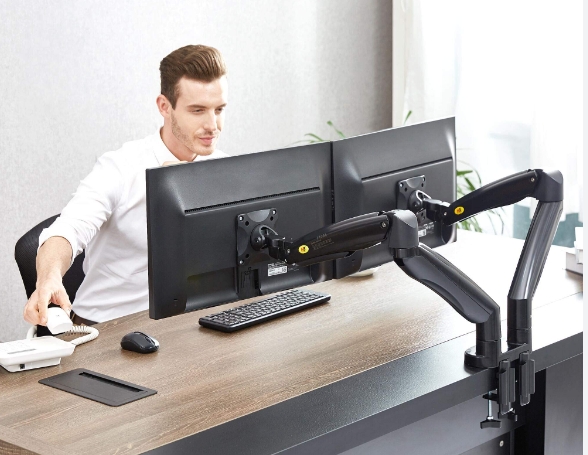Setting up a dual monitor workstation can significantly enhance productivity and comfort. Here’s a comprehensive guide on how a dual monitor setup can benefit you and tips on optimizing it for maximum efficiency:
Benefits of a Dual Monitor Setup

1. Increased Productivity:
- Multitasking: With two screens, you can easily multitask without constantly switching between tabs. This is particularly useful for tasks that require referencing multiple documents or applications simultaneously.
- Extended Desktop Space: Having more screen real estate allows for better organization of your workspace. You can have a primary working screen and a secondary screen for email, research, or communication tools.
2. Enhanced Comfort:
- Reduced Eye Strain: By spreading out your tasks across two monitors, you reduce the need to resize windows and strain your eyes with small text.
- Better Ergonomics: A dual monitor setup can promote better posture and ergonomics. Positioning the monitors at eye level and in line with your natural gaze can prevent neck and shoulder strain.
3. Improved Workflow:
- Seamless Transitions: Dual monitors facilitate a seamless transition between tasks, which can reduce cognitive load and improve focus.
- Efficient Communication: For remote work or team collaboration, one monitor can be dedicated to video conferencing while the other is used for ongoing tasks.
Optimizing Your Dual Monitor Setup
1. Monitor Placement:
- Alignment: Position the monitors so that their centers are aligned and they are at the same height. This reduces neck strain and makes for a seamless visual experience.
- Angle: Slightly angle the monitors towards each other to create a curved viewing surface that matches the natural curvature of your eyes.
2. Ergonomic Adjustments:
- Eye Level: Ensure that the top of the screens are at or slightly below eye level. This can be adjusted using monitor stands or adjustable arms.
- Distance: Place the monitors at a comfortable distance (typically an arm’s length away) to reduce eye strain.
3. Display Settings:
- Resolution and Scaling: Adjust the resolution and scaling settings to ensure text and images are sharp and easy to read. Both monitors should ideally have the same resolution for a consistent experience.
- Color Calibration: Calibrate the color settings on both monitors to ensure consistency across screens, especially important for design and creative work.
4. Software Configuration:
- Taskbar Settings: Customize your taskbar to show on one or both monitors, depending on your preference.
- Window Management Tools: Use software tools or built-in operating system features that facilitate window management across multiple monitors. For example, Windows’ Snap Assist or macOS’ Mission Control.
5. Desk Organization:
- Cable Management: Use cable clips, sleeves, or trays to keep your desk tidy and free from clutter.
- Peripheral Placement: Position your keyboard, mouse, and other peripherals within easy reach, and ensure they are aligned with your primary monitor to maintain ergonomic posture.
Practical Use Cases
1. Professional Work:
- Developers: One screen can display code while the other shows documentation or a running application.
- Designers: Work on a design on one screen while having tools, palettes, or reference materials on the second screen.
- Writers: Write or edit a document on one screen while researching or referencing notes on the other.
2. Remote Work and Collaboration:
- Video Conferencing: Participate in video calls on one monitor while viewing documents or taking notes on the other.
- Project Management: Keep project management tools and communication platforms open on one screen while working on tasks on the other.
3. Personal Use:
- Gaming and Streaming: Play games on one monitor while streaming or interacting with viewers on the other.
- Media Consumption: Watch videos or tutorials on one screen while taking notes or following along on the other.
Conclusion
A dual monitor setup can greatly enhance both productivity and comfort by providing additional screen space and improving ergonomics. By carefully configuring your monitors and workspace, you can create an efficient and comfortable environment that supports a wide range of professional and personal activities. Whether for multitasking, reducing eye strain, or improving workflow, investing in a dual monitor setup is a practical choice for many users.
